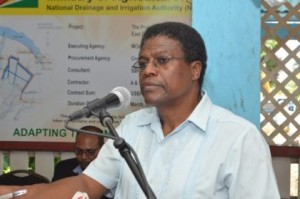The Cunha Canal project which will be funded at a cost of over US $3M and which will greatly benefit residents and farmers on the East Bank Demerara, will soon commence.
The project is to be executed by the Ministry of Agriculture through the National Drainage and Irrigation Authority (NDIA) while being administered by the World Bank.
It is scheduled for completion by December 2018, and is funded through the Guyana REDD+ Investment Fund (GRIF).
The Cunha Canal is located on the western side of the East Demerara Water Conservancy (EDWC) and discharges water from the conservancy and local areas into the Demerara River. It is a key element of both the EDWC and the East Bank Demerara drainage systems and currently does not function efficiently.
Frederick Flatts, CEO of the NDIA explained that, “We will be rehabilitating the intake structure from the conservancy the head regulator that’s in a bad state right now. We also will be rehabilitating the sluice at Land of Canaan. The sluice was known as the Correia sluice many years ago.”
The main objective of the project is to increase the capacity of the Cunha Canal to drain the EDWC and local agricultural areas adjoining it. Its execution will see other enabling works being undertaken.
“We will also be building a new public road bridge to allow water from the Cunha Canal to pass out to the river, and also if we are doing the sluice and the regulator at the conservancy, we will have to do the entire channel including the outfall channel,” Flatts explained.
The contract for the project was signed in February 2016 by Finance Minister Winston Jordan and World Bank Representatives. It was subsequently handed over to the Ministry of Agriculture.
At that time Minister Jordan had said, “We’re happy that farmers and various aspects of the population and businesses that cover this wide area that the canal traverses will have some level of relief brought to them, and I hope in the context of future interventions, both from GRIF and the World Bank, that together these can mitigate the effects over time of climate change on Guyana’s economy.”
The EDWC provides flood control during the wet season and provides irrigation water to agricultural lands during the dry season, especially important for rice and sugar production which represents 4.3 and 3.8 percent of the country’s GDP respectively. It also provides drinking water to urban areas.
The EDWC covers an area 571 kilometres (km) and stores approximately 250 million cubic meters of water at the maximum safe-operating water level. It is dammed on three sides by a shallow earth embankment 67 km long, lying parallel to the Demerara River, the Atlantic Ocean and Mahaica River.
A series of canals controlled by sluices drain water from the EDWC in order to reduce water levels and avoid overtopping or stressing the dams which may increase the risk of structural failure. The 2005 floods left the dam in a weakened state and highlighted vulnerabilities in other flood mitigation infrastructure to adequately drain flood water quickly.






